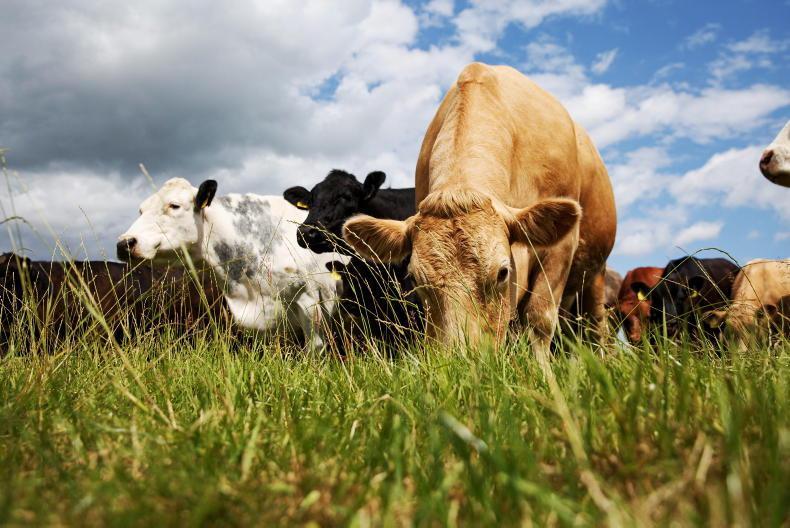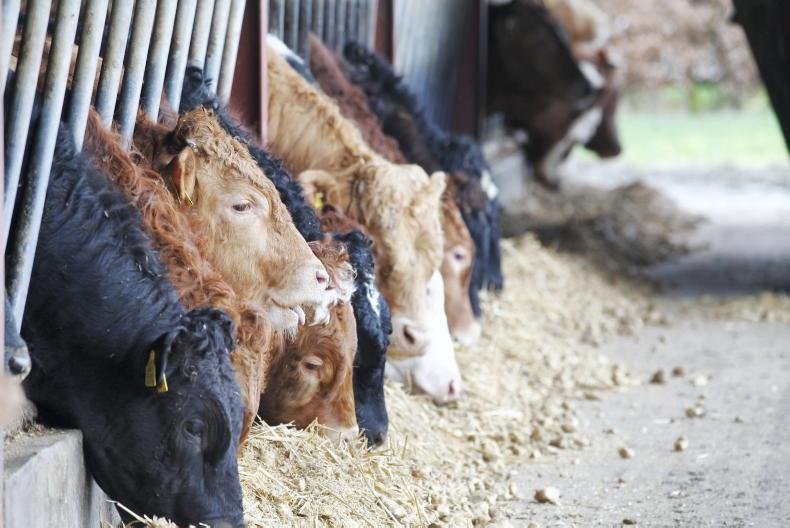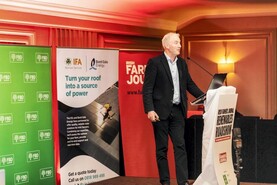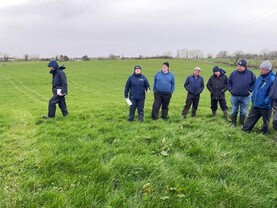A key goal of grass-based beef production systems is to exploit grazed pasture so as to optimise animal liveweight performance over its lifetime, thereby reaching finishing age as early as possible.
Data from Teagasc Grange for spring-born suckler weanling-to-beef and dairy calf-to-beef systems has highlighted the importance of finishing age on farm profitability (Table 1).
Reducing finishing age of animals in the Irish cattle herd has also been recognised in the Irish climate action plan and the Teagasc Marginal Abatement Cost Curve (MACC) as a cost-effective measure to reduce agricultural greenhouse (GHG) emissions.
Liveweight performance is influenced by factors such as feed availability and quality, animal health and genetics.
Liveweight performance targets during indoor ‘store’ winter feeding periods are based on optimising compensatory growth during the subsequent grazing season.
A proportion of cattle, typically early-spring born animals or early-maturing breeds, will be suitable for slaughter at the end of the second grazing season.
Most beef cattle are housed for a second winter and either finished at approximately 24 months of age or returned to pasture for a third grazing season.
Good progress has been made at farm level in recent years with finishing age reduced by almost one week per year between 2011 and 2021.
Importantly, this has been achieved with almost no reduction in carcase weight (341 kg in 2011 v 338kg in 2021). This has led to a reduction of costs on farms, particularly feed, while retaining output and reducing GHG emissions. Indeed, by finishing cattle two months earlier, approximately 430,000t CO2e are abated annually.
Recent analysis has evaluated the potential to further reduce finishing age in the beef herd. A consideration in this regard is the changing structure of the cattle herd with dairy cow numbers increasing and suckler cow numbers reducing.

Seasonality tends to influence beef price with price declines in mid- to late autumn coinciding with peak supply of finished cattle.
In 2011, there were approximately 1.1m of each whereas in 2021, dairy cow numbers had increased to 1.5m (+45%) while suckler cow numbers had declined to 890,000 (-18%).
Data from the FAPRI-Ireland model indicates that, based on current policies and the international market outlook, these trends will continue with the dairy cow population expected to reach 1.7m in 2030 and suckler cow numbers to decline to approximately 670,000.
Based on these projections, the total number of “prime” cattle finished is likely to remain largely unchanged. However, beef output may decline slightly due to the lighter carcase weight of dairy and dairy-beef cattle when compared to suckler beef cattle.
Maintaining beef output from the Irish beef sector is desirable from a global GHG emissions perspective given the projected increase in beef demand globally and the low GHG emissions intensity of Irish beef when compared to the global average.
Population changes
The impact of population changes in the Irish cow herd on the respective numbers of prime cattle finished from each of the breed types is shown in Figure 1, with an increase in dairy and dairy-beef cattle finished and a corresponding reduction in suckler-bred cattle.
In recent years, the number of dairy heifer replacements produced using sexed semen has increased substantially.
An outcome of this approach is a reduction in the numbers of dairy-sired males and an increase in the number of beef-sired calves born from the dairy herd.
A scenario whereby 90% of dairy heifer replacements are bred using sexed semen was considered and this showed that, instead of increasing by 14%, the number of dairy-sired males finished would reduce by 87% relative to 2021.
Correspondingly, the number of dairy-beef cattle finished would increase by 56%. This has important implications for the beef merit of cattle from the dairy herd and, to a lesser extent, given the preference to use early-maturing beef breed sires in the dairy herd, potential to finish cattle at earlier ages.
There is enormous uncertainty in projecting future changes in finishing age given the multitude of factors involved as alluded to earlier.

Good progress has already been achieved on reducing the finishing age of cattle in Ireland.
For this analysis (presented in Table 2), the potential to finish suckler- and dairy-bred cattle at earlier ages was evaluated using 2021 as the baseline and developing scenarios using finishing age data from:
‘High-performing’ farms such as the beef technology demonstration farms in the Future Beef and Dairy-Beef 500 farms (pathway one), and Research farms such as Teagasc Grange (pathway two). For pathways one and two, finishing age is reduced by 67 and 98 days, respectively, in 2030 when compared to 2021. Both scenarios are challenging but, in particular, pathway two can be considered a ‘stretch target’ requiring aggressive incentivisation and an intensive advisory campaign around the key management changes needed to achieve a younger finishing age while maintaining carcase.
Seasonality
Seasonality tends to influence beef price with price declines in mid- to late autumn coinciding with peak supply of finished cattle. Conversely, prices tend to be higher during the early summer period when supply is lowest. Figure 2 highlights the current seasonality of supply in the Irish beef industry and the impact of pathways one and two on seasonality in 2030. The impact of earlier finishing is to move the peak supply to earlier in the year with the peak now occurring in the June to August period.
Challenges and progress
The challenge from the meat industry perspective is to incentivise supply in the late winter period. Likewise, from a farm systems perspective, the question arises as to optimising grazed pasture in the late grazing season.
Typically, a proportion of this pasture would have been grazed by finishing cattle, many of which will now be finished earlier in the season.
Options may include reducing nitrogen fertiliser application rates, operating at lower stocking rates, extending the grazing season and/or purchasing store cattle earlier in the year.
It is clear that good progress has already been achieved on reducing the finishing age of cattle in Ireland.
Advances in grassland management, nutrition, health, as well as genetic gain for carcase traits, have contributed to substantial reductions in finishing age in recent years but more progress can be made at farm and industry level as outlined above.
Earlier finishing is a key profit driver for Irish cattle farms and can contribute to improvements in farm economic performance, provided it does not involve replacing grazed grass in the diet with more expensive concentrate feeds.
A key goal of grass-based beef production systems is to exploit grazed pasture so as to optimise animal liveweight performance over its lifetime, thereby reaching finishing age as early as possible.
Data from Teagasc Grange for spring-born suckler weanling-to-beef and dairy calf-to-beef systems has highlighted the importance of finishing age on farm profitability (Table 1).
Reducing finishing age of animals in the Irish cattle herd has also been recognised in the Irish climate action plan and the Teagasc Marginal Abatement Cost Curve (MACC) as a cost-effective measure to reduce agricultural greenhouse (GHG) emissions.
Liveweight performance is influenced by factors such as feed availability and quality, animal health and genetics.
Liveweight performance targets during indoor ‘store’ winter feeding periods are based on optimising compensatory growth during the subsequent grazing season.
A proportion of cattle, typically early-spring born animals or early-maturing breeds, will be suitable for slaughter at the end of the second grazing season.
Most beef cattle are housed for a second winter and either finished at approximately 24 months of age or returned to pasture for a third grazing season.
Good progress has been made at farm level in recent years with finishing age reduced by almost one week per year between 2011 and 2021.
Importantly, this has been achieved with almost no reduction in carcase weight (341 kg in 2011 v 338kg in 2021). This has led to a reduction of costs on farms, particularly feed, while retaining output and reducing GHG emissions. Indeed, by finishing cattle two months earlier, approximately 430,000t CO2e are abated annually.
Recent analysis has evaluated the potential to further reduce finishing age in the beef herd. A consideration in this regard is the changing structure of the cattle herd with dairy cow numbers increasing and suckler cow numbers reducing.

Seasonality tends to influence beef price with price declines in mid- to late autumn coinciding with peak supply of finished cattle.
In 2011, there were approximately 1.1m of each whereas in 2021, dairy cow numbers had increased to 1.5m (+45%) while suckler cow numbers had declined to 890,000 (-18%).
Data from the FAPRI-Ireland model indicates that, based on current policies and the international market outlook, these trends will continue with the dairy cow population expected to reach 1.7m in 2030 and suckler cow numbers to decline to approximately 670,000.
Based on these projections, the total number of “prime” cattle finished is likely to remain largely unchanged. However, beef output may decline slightly due to the lighter carcase weight of dairy and dairy-beef cattle when compared to suckler beef cattle.
Maintaining beef output from the Irish beef sector is desirable from a global GHG emissions perspective given the projected increase in beef demand globally and the low GHG emissions intensity of Irish beef when compared to the global average.
Population changes
The impact of population changes in the Irish cow herd on the respective numbers of prime cattle finished from each of the breed types is shown in Figure 1, with an increase in dairy and dairy-beef cattle finished and a corresponding reduction in suckler-bred cattle.
In recent years, the number of dairy heifer replacements produced using sexed semen has increased substantially.
An outcome of this approach is a reduction in the numbers of dairy-sired males and an increase in the number of beef-sired calves born from the dairy herd.
A scenario whereby 90% of dairy heifer replacements are bred using sexed semen was considered and this showed that, instead of increasing by 14%, the number of dairy-sired males finished would reduce by 87% relative to 2021.
Correspondingly, the number of dairy-beef cattle finished would increase by 56%. This has important implications for the beef merit of cattle from the dairy herd and, to a lesser extent, given the preference to use early-maturing beef breed sires in the dairy herd, potential to finish cattle at earlier ages.
There is enormous uncertainty in projecting future changes in finishing age given the multitude of factors involved as alluded to earlier.

Good progress has already been achieved on reducing the finishing age of cattle in Ireland.
For this analysis (presented in Table 2), the potential to finish suckler- and dairy-bred cattle at earlier ages was evaluated using 2021 as the baseline and developing scenarios using finishing age data from:
‘High-performing’ farms such as the beef technology demonstration farms in the Future Beef and Dairy-Beef 500 farms (pathway one), and Research farms such as Teagasc Grange (pathway two). For pathways one and two, finishing age is reduced by 67 and 98 days, respectively, in 2030 when compared to 2021. Both scenarios are challenging but, in particular, pathway two can be considered a ‘stretch target’ requiring aggressive incentivisation and an intensive advisory campaign around the key management changes needed to achieve a younger finishing age while maintaining carcase.
Seasonality
Seasonality tends to influence beef price with price declines in mid- to late autumn coinciding with peak supply of finished cattle. Conversely, prices tend to be higher during the early summer period when supply is lowest. Figure 2 highlights the current seasonality of supply in the Irish beef industry and the impact of pathways one and two on seasonality in 2030. The impact of earlier finishing is to move the peak supply to earlier in the year with the peak now occurring in the June to August period.
Challenges and progress
The challenge from the meat industry perspective is to incentivise supply in the late winter period. Likewise, from a farm systems perspective, the question arises as to optimising grazed pasture in the late grazing season.
Typically, a proportion of this pasture would have been grazed by finishing cattle, many of which will now be finished earlier in the season.
Options may include reducing nitrogen fertiliser application rates, operating at lower stocking rates, extending the grazing season and/or purchasing store cattle earlier in the year.
It is clear that good progress has already been achieved on reducing the finishing age of cattle in Ireland.
Advances in grassland management, nutrition, health, as well as genetic gain for carcase traits, have contributed to substantial reductions in finishing age in recent years but more progress can be made at farm and industry level as outlined above.
Earlier finishing is a key profit driver for Irish cattle farms and can contribute to improvements in farm economic performance, provided it does not involve replacing grazed grass in the diet with more expensive concentrate feeds.








 This is a subscriber-only article
This is a subscriber-only article










SHARING OPTIONS: